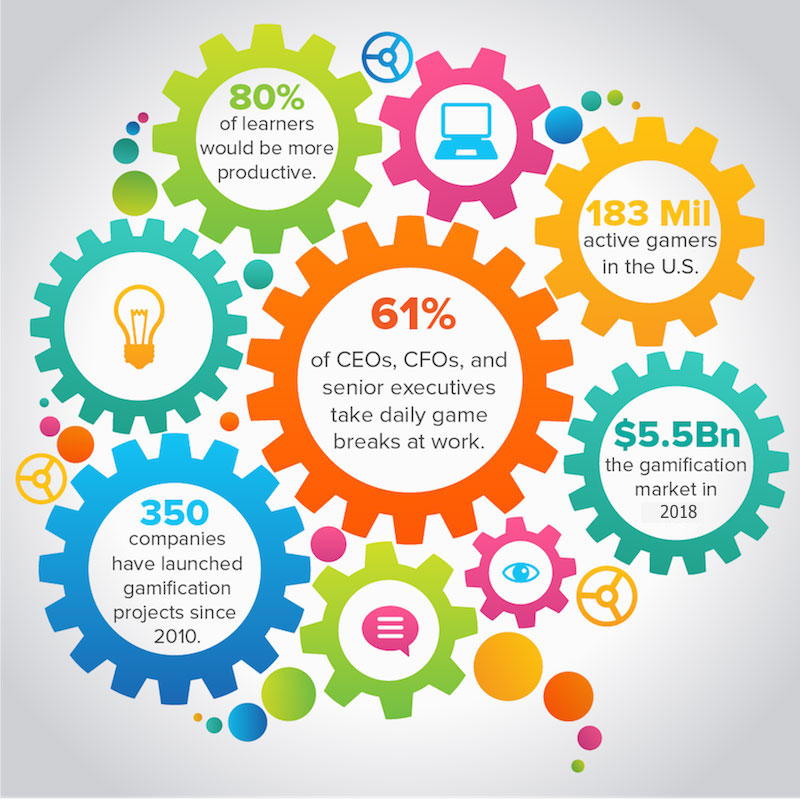Are you struggling to connect with your users? Or could you be concerned that your audience is losing interest in your brand? It can be a tricky task keeping users loyal to your company, but more businesses are leveraging gamification as a way of bringing new levels of engagement to prospective and existing customers alike.
There are few better ways of encouraging users to continue returning to your brand and enabling them to interact with other customers than through gamification. But what exactly does this term mean? And how can it help to drive engagement with your business? Let’s take a deeper look at gamification and its uses within the world of UX.
What is gamification?
 (source: digitalchalk)
(source: digitalchalk)
As the chart above shows, the gamification market has grown exponentially towards attaining a value of over $5.5bn dollars in recent years. In fact, it’s likely that UX gamification plays a role in your daily life already. Popular apps like Duolingo and Strava have developed successful game-based approaches towards self-improvement tasks like learning new languages or running – with both companies rewarding users based on their progress and achieving certain milestones in their development.
But what is gamification? Naturally, the term means to transform an activity or process into a game that users can play.
The Interaction Design Foundation refers to gamification as “a technique where designers insert gameplay elements in non-gaming settings so as to enhance user engagement with a product or service. By weaving suitably fun features such as leaderboards and badges into an existing system, designers tap users’ intrinsic motivations so they enjoy using it.”
Businesses have been successfully adding gamification setups to their apps for much of the last decade, and the practice is only gathering momentum as mobile applications continue to become more sophisticated and adaptive.
Push engagement
Users crave gratification and rewards for their efforts. Gamification has the power to convert user experience into a community-based competition. Customers can transition between different levels and leaderboards and gain rewards for the time they commit to using the app or browser game.
Valuable contributions such as initiating discussions, posting product reviews, replying to queries or encouraging friends to sign up can tangibly be rewarded with in-game items or achievements.
By building a rewards-based game, you’re actively incentivizing user engagement – making the whole process more appealing to both customers and prospective customers. As an example of gamification in action, John Findlay, co-founder of Launchfire offered up the scenario of a bank looking to acquire new customers: “Rather than creating ads that talk about how your bank [or financial service business] is different, create an online game that challenges players to build a financial empire by making good investment decisions,” Findlay explained.
Build loyalty
Gamification can also build a sense of loyalty for customers through the medium of points, ‘badges’ and online leaderboards – these practices help to enable users to become advocates of your brand.
The act of offering discounts or free merchandise for a specific action like posting a helpful and positive product review helps to ensure that customers gain a sense of value – thus increasing their loyalty further with meaningful engagements.

(source: Educraft)
The image above shows how achievements like badges can pave the way for future engagements. Entertainment app, QuizUp uses achievements to reward users for playing their array of games and uses each notification as a prompt to encourage more gaming.
Create a community
Another common theme that runs through plenty of gamification setups is the presence of the ‘share’ feature. As we can see in the prior image, users have the option of sharing their achievements on social media platforms. This helps to develop the presence of a brand and build an active online community.
If utilized in the correct manner, gamification can help to build a brand new interactive ecosystem within your customer community, aligning the behavior of users alongside your business’s objectives. As more customers develop their engagement, they increase the chances of more users becoming engaged in your brand – thus helping to expand your community and further develop loyalty.
Utilize user data
Another perk of the newfound levels of engagement brought by gamification comes in the form of greater user data available to your company. Of course, there are plenty of ways in which to attain the data of your customers, but gamification has the power to bring more accuracy to your results.
The greater levels of community-generated by users engaging in your games means that more will be actively discussing their progress and your brand in general. These extra organic discussions mean that you can build more self-awareness and optimize campaigns in order to perform better, with greater customer insights generated through replies, shared content and the type of topics that users discuss.
Fundamentally, in a world that’s driven by instant-gratification and time-effectiveness, gamification pays dividends in enabling users to feel as if their engagement with your brand is being rewarded. While there’s plenty of customer insights available through this form of engagement, the true reward will be found in the value that gamification brings to your company – making it much easier to level up your UX model.
